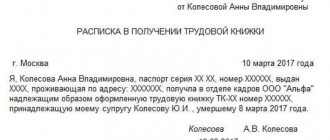Content
- Features of dismissal in the order of transfer to another organization
- If the manager refuses to let the employee go
- Translation and processing
- Types of transfers
- Options for dismissal in order of transfer to another organization
- Step-by-step instructions for dismissal of a transfer initiated by an employee
- Dismissal of an employee by his consent (the initiative comes from the manager)
- Basic documents for registration of dismissal
- Compensation upon dismissal by transfer
- Leave on transfer
- Who can be dismissed by transfer?
- Advantages and disadvantages of dismissal
- Conclusion
Key points about dismissal by transfer
Dismissal upon transfer to another organization involves the termination of the employment contract in force between the citizen and the employer, followed by its almost simultaneous execution with the new employer.
The manager of the current place of employment must have confirmed grounds for terminating the employment contract with the employee.
This is a written notification addressed to the current management from the future manager of the employee.
How to dismiss an employee by transfer to another employer at his request or with his consent?
The dismissing party has the right not to release the employee without working the statutory period of 2 weeks, since this time is required to find a replacement for the departing specialist. But by agreement of the parties, dismissal without service is allowed.
Question: Is it possible, upon dismissal by transferring an employee to another organization, not to pay compensation for unused vacation, but to retain the right to vacation? View answer
Exemption from work by transfer of citizens of any category is allowed, including mothers of many children, workers on maternity leave, single mothers, if they have expressed written consent or shown their own initiative.
Important! When changing the place of employment by transfer, the receiving company is obliged to employ the new employee within 30 days. Otherwise, by a court decision, the new management will be obliged to hire the citizen, or he will be reinstated to his previous place of employment. There are no such social guarantees when you resign at your own request.
Features of dismissal in the order of transfer to another organization
To better understand the depth of the issue, let's start with a definition.
Dismissal by transfer is the termination of an employee’s contract (employment contract) with one employer and its simultaneous conclusion with another employer.
For example, an employee occupies a permanent position in one organization, but he was offered a more profitable job at another enterprise. Then he can transfer from one place of work to another. In fact, the employee quits the old enterprise and gets a job at a new one.
But before dismissing a transfer employee, the manager must have certain reasons. This is a letter of invitation from a future employer to a present one. Subject to the employee's consent and written request, the current manager may dismiss the transfer employee.
The Labor Code does not prescribe a clear algorithm for the manager’s action in this case. Mention of transfer to another organization can be found in Article 77 of this document. Therefore, when preparing documents for dismissal due to transfer, reference is made to Article 77 of the Labor Code of the Russian Federation.
In fact, business managers do not receive much benefit from this process. The same cannot be said about the employees. In case of dismissal in this way, the state protects the rights of the citizen, thanks to which he receives 100% employment.
About working off
Since a transfer to another organization based on an employee’s application is equivalent to voluntary dismissal, an employee, leaving his current place of work, is required to work for two weeks (in accordance with Article 80 of the Labor Code of the Russian Federation).
This is due to the fact that the employer needs time to find a new employee to replace the one who quits.
However, if the parties come to an agreement, it is possible to terminate the employment contract without working out.
If the manager refuses to let the employee go
If an employee has expressed a desire to resign by transfer, but his employer is against this, then the employee has no choice but to leave of his own free will. In this case, the employee is left without protection before the new manager.
That is, if dismissal occurs due to transfer, then the receiving party must employ the employee within a month, otherwise he may go to court. By a court decision, they can either reinstate him to his previous place of work, or oblige the head of the receiving enterprise to hire this employee.
If the dismissal occurs at will, then there will be no one to file a claim with.
Types of transfers
Dismissal due to transfer can be external or internal.
Internal transfer (transfer within the company) is when the employer remains unchanged, but the employee’s position, place of work, etc. changes. Such a transfer can be either permanent or temporary.
External transfer (transfer to another company) – occurs when an employee moves from one employer to another. At the same time, at the new place of work they are required to hire him only for a permanent position.
In any case, the employee’s consent is a prerequisite for the transfer.
External translation: in what cases can you use it?
A transfer through dismissal can be made only with the consent of the employee. Any employee can take advantage of the opportunity to terminate a current employment contract under clause 5 of Article 77 of the Labor Code in the following cases:
- moving to a new place of residence in another area;
- moving to the place of training (if the employee combines work with training);
- reaching an agreement between the current and potential employer (does not require obvious reasons, but the employee’s consent is required).
Options for dismissal in order of transfer to another organization
There are several options for dismissing transfer employees. It all depends on who takes the initiative.
Option 1: The employee independently found an organization where he would like to work.
If the head of this organization is ready to hire an employee, then he writes a letter of invitation addressed to the current head, where he confirms that he is ready to hire his employee.
This written notice will be mailed or personally delivered to the incumbent. If he agrees with the transfer, the employee writes a letter of resignation in the order of transfer, on the basis of which a dismissal order is issued, an entry is made in the work book, personal card, final payment is made, and documents are issued in person (work book and income certificate for 2 years).
With them, the employee goes to a new place of work, where he is hired.
Option 2: The initiative comes from the manager.
There are times when an organization urgently needs to reduce its workforce or fire some staff. In this case, the employer can independently find a new place of work for the employee. Managers discuss all the nuances and receive written consent to the transfer from the employee. A tripartite agreement is signed, which specifies the position, salary, working conditions, etc.
What follows is the standard translation procedure.
Each of these options has its own characteristics. Therefore, any manager needs to know and be able to fill out all the necessary documentation. Now we will analyze each translation option in detail so that you know all the intricacies of this procedure.
If the initiator of the transfer is a new employer
If a company is interested in hiring a specific specialist, it can send a petition to the organization requesting the transfer of the employee. In the letter, the potential employer invites the current employer to consider the possibility of a transfer under certain conditions. The letter contains the following information:
- Full name of the employee.
- Proposed vacancy and salary.
- Estimated hiring date.
This is also important to know:
How an employee is laid off from an enterprise in 2019
The current employer reviews the letter within the period established by the business rules (usually 5 working days) and makes a decision. If you agree, the corresponding visa will be stamped on the document. The employee who is offered a new position is informed in writing about the request received and receives his consent to the transfer or a reasoned refusal.
Important
If the issue is resolved positively, the responsible specialist sends a letter to the interested party confirming the possibility of the transfer and the employee’s consent to change jobs.
Step-by-step instructions for dismissal of a transfer initiated by an employee
- The current employer receives a letter of invitation from an organization that is ready to hire his employee. It is drawn up in any form on the organization’s letterhead. It must indicate the position for which the employee is being hired and the approximate date of employment. Sometimes such a letter indicates the amount of the future salary, but this is not necessary.
- An employee who wants to transfer writes a statement addressed to the head of the organization stating that he wants to resign due to the transfer.
- After signing the application, a letter is sent to the organization that will employ the dismissed employee confirming the transfer. This item is optional, and the letter is drawn up for management’s consideration.
- Next, the head of the enterprise creates an order, where it is necessary to indicate on whose initiative the transfer is being carried out “In the order of transfer at the request of the employee.” In addition, the order must make reference to clause 5, part 1, article 77 of the Labor Code of the Russian Federation.
- After signing the order, it is registered in the Register of Orders for Personnel.
- The order must be communicated to the employee in writing.
- After this, in the employee’s personal card (T-2) on the fourth page, an entry is made about the employee’s dismissal, where a reference is also made to Art. 77 Labor Code of the Russian Federation. The employee must be familiar with all the records, after which he puts his signature on the card.
- After this, a corresponding entry is made in the employee’s work book, according to the Instructions for filling out the work book. There are 2 recording options:
In addition, the work book indicates the number of the dismissal order and its date. The entry must be made without abbreviations, certified by the seal and signature of the manager.
- On the last working day, the employee is paid by issuing a settlement note (form T-61). Thus, the employee receives compensation for vacation and wages for days worked.
- After which the former employee is given a work book. An entry about this must be made in the Book of Accounting for the Movement of Labor Books, where the employee puts his signature.
- In addition to the work book, a certificate of salary for 2 months is issued.
- After this, the dismissed employee is obliged to find a new job within 1 month.
- When registering at a new location, a note is made in all relevant documents that it has been accepted for transfer.
Is the employee’s Labor Code filled out when moving to another employer?
When filling out work books, the employer must be guided by the following regulations:
- Labor Code of the Russian Federation. Art. 66 defines the basic rules for maintaining this document, and the remaining rules describe the rules that govern the conclusion, amendment and termination of employment contracts.
- Rules for maintenance and storage, approved by Decree of the Government of the Russian Federation No. 225 of 2003.
- Instructions for filling, approved by Decree of the Ministry of Labor of the Russian Federation No. 69 of the same year and developed in accordance with the Rules for maintenance and storage.
Together these regulations indicate the following:
- All information about hiring, transfers within the organization, incentives and dismissal of the employee is entered into the work book.
- Dismissal means, among other things, transfer to another employer.
Therefore, if an employee has been transferred to another employer, then a record of termination of the contract with the previous employer must be included in the employee’s book.
Dismissal of an employee by his consent (the initiative comes from the manager)
This version of the transfer procedure is similar to the previous one, so we will not repeat ourselves, but will talk about the differences and features of the transfer on the initiative of the manager.
- The heads of enterprises agree among themselves that one fires the employee, and the second hires. This can be confirmed by a letter of invitation (as in the first option).
- After this, the employee himself must be familiarized with the upcoming transfer. He must be told in writing about the position he will hold, the working conditions, and the salary amount. If an employee does not agree to a transfer, then no one can force him to change his job.
If the employee agrees to the transfer, he can write “I agree to the transfer” on the written notice, adding a date and signature. A tripartite agreement is drawn up.
- After which the receiving party receives a confirmation letter.
- At an enterprise where an employee is fired, the manager issues a dismissal order, which states that the dismissal occurs with the consent of the employee. It is also necessary to refer to Article 77 of the Labor Code of the Russian Federation.
- After which, appropriate entries are made in the work book and personal card, which also indicate that the dismissal is carried out with the consent of the employee . A sample record of dismissal in the order of transfer in the work book was discussed earlier in the first version.
- All records and orders must be presented to the employee against his signature.
- A settlement is made with the payment of all compensation, after which a work book and a certificate of income for 2 years are issued.
Also read: Dismissal of employment by agreement of the parties.
How is the translation agreement documented?
Depending on the chosen option for reaching an agreement, the document flow changes.
Exchange of letters of consent
In this case, the following procedures must be followed:
- An employee writes a free-form application to the administration of his company about his desire to transfer to another employer.
There is no standard form for such a document . But it must include:
- FULL NAME. and the name of the worker's position.
- Request for dismissal by way of transfer to another company.
- Estimated date of separation.
a job offer from a new employer to it
SAMPLE INVITATION TO WORK FOR TRANSLATION
- A potential employer sends a free-form offer letter to the current employer.
It should contain the following data:
- Company name.
- FULL NAME. and the position of the employee who is planned to be hired.
- Proposal to transfer an employee.
- The deadline for approval by the current employer and an indication of the form in which it should be given.
- The date from which the employee will start a new job, as well as the name of his position.
- Signatures of authorized persons.
SAMPLE OFFER LETTER FROM A NEW EMPLOYER
- If there are no objections to the transfer, the current employer sends a response in the form of a letter of consent in any form.
It states:
- The date and incoming number of the offer letter to which the response is given.
- Information that an application for transfer has been received from the employee.
- The expected date on which the company agrees to release its employee.
SAMPLE LETTER OF CONSENT FOR TRANSLATION
The described option is quite labor-intensive and time-consuming, so in practice another method is more often used - using a tripartite agreement.
3 party agreement
It is concluded in writing by all participants in the process. Such a document also does not have an established template and is drawn up in any form. It should contain the following data:
- Identification information about the parties to the agreement - employers, employees.
- Clear confirmation of the intention, as well as the conditions for the future transfer, including the dates of dismissal from the old place and admission to the new one, future position and basis with reference to clause 5 of part 1 of Art. 77 Labor Code of the Russian Federation.
- Additional conditions, if the parties consider them significant.
TRIPARTY AGREEMENT FOR TRANSLATION FORM
Basic documents for registration of dismissal
All letters are written in any form. The application from the employee and the order from the manager must be drawn up in accordance with all the rules. Below we provide a table with which you can correctly draw up the necessary document.
| Application from an employee | 1. Name of the addressee; 2. Full name of the employee; 3. Title of the document (application); 4. The essence of the statement “Please fire me...”; 5. Date; 6. Signature. |
| Dismissal order (order) | 1. Name of the organization; 2. Name of the document and its number (Order No....); 3. Date of compilation; 4. Method of terminating the ore contract; 5. Full name of the dismissed employee; 6. Personnel number, position; 7. Basis for calculation; 8. Information about available documents that confirm the legality of dismissal due to transfer; 9. Date and signature of the manager; 10. The column “I have read the order,” where the resigning employee puts his signature. |
Compensation upon dismissal by transfer
On the last working day, a full payment is made to the employee. Most often this is payment for his days worked and compensation for vacation.
Let's look at how compensation is calculated using an example.
Example: Let’s assume that an employee quits on June 30, 2016, but he did not go on vacation this year. If his annual leave is 24 days, then the company must pay him compensation for 12 days.
Who can be dismissed by transfer?
Any employee can be fired in this way if they have given their consent or taken the initiative on their own. Single mothers, mothers of many children, women on maternity leave, etc. fall into this category.
Also read: Is it possible to fire a pregnant woman and the procedure for dismissal during vacation.
Advantages and disadvantages of dismissal
We will consider all the positive and negative aspects of dismissal due to transfer in the table.
| Advantages | Flaws | |
| For employee | 1. No probationary period is established at the new place; 2. Mandatory employment within 1 month; | 1. Leave is not saved |
| For the manager | 1. When staffing is reduced, the employee is not fired, but transferred. | 1. Loss of specialists; 2. Search for new personnel. |








